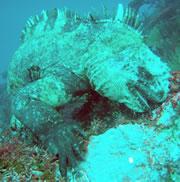 A Galapagos iguana grazes on the algae of a kelp forest.Sean Connell / PNAS
A Galapagos iguana grazes on the algae of a kelp forest.Sean Connell / PNASKelp forests, long held to be limited to cold waters, have been discovered in the tropics and may be more widespread than previously thought, new research shows.
These expanses of large brown seaweeds are known to serve as hotspots for marine diversity in colder climes; they teem with fish and other animals that take shelter in their dense stands. So the discovery of previously unknown forests in the tropics suggests there are unexplored ecosystems there too.
Kelp are renowned for their quick growth, sometimes spurting upwards more than 20 centimetres a day, thanks to vascular systems that are fine-tuned for speedily distributing sugars and nutrients. To fuel this growth, kelp require ample nutrients, especially nitrate. And most nutrient-rich waters are in cooler climes; textbooks have deemed the warm waters of the tropics, notoriously nutrient deficient, as kelp-free zones.
Marine ecologist Michael Graham of Moss Landing Marine Laboratories in California knows this mandate well. The laboratory where he works lies just north of some infamous tangled kelp beds, so thick that a local triathlon nicknamed the swim segment in Monterey Bay 'the kelp crawl'.
When the animation film studio Pixar consulted Graham about the scientific accuracy of their film Finding Nemo (see 'The fabulous fish guy'), in which the star was a clown fish living in a coral reef, Graham told them that the worst mistake they could make in the film would be to put a cold-water kelp forest next to a tropical coral-reef. That sent Pixar back to the studio to remove the kelp forests they'd already drawn in.
Now Graham and his colleagues have delved deeper into the question of just where kelp forests can exist.
Not-so-trivial pursuit
Their work was spurred by occasional fishermen's reports of finding a piece of kelp clinging to an anchor or snared in a net in tropical seas near the Galápagos, Brazil or the Philippines. Divers too know about a few pockets of kelp in areas such as the Galápagos. But such reports were few, and many researchers wrote off these kelp as scattered relics left over from a time when the waters were cooler.
"It was thought that you were just seeing the last survivors of a past era," says Graham. "People had just brushed them aside as trivial curiosities."
Louis Druehl, now of Bamfield Marine Sciences Center in British Columbia, thought the findings might be more significant. So he teamed up with Graham and other colleagues to model the conditions that kelp need to grow.
Their model predicted cold-water kelp forests in locations that matched those already known, but it also churned out predictions, published this week in the Proceedings of the National Academy of Sciences of the USA, of vast kelp forests in tropical waters1. These forests typically grew more than 20 metres beneath the sea surface, in regions where cold, nutrient-rich bottom waters, and warm, clear surface waters, yield both the nutrients and the light that kelp need.
Seek and ye shall find
One of the largest tropical forests was predicted to be in the seas surrounding the Galápagos archipelago. Graham and his colleagues scuba dived along the west coast of Fernandina Island and Isabela Island and found forests of Eisenia galapagensis, a shrubby kelp known to be endemic to the Galápagos — but not known to exist in vast forests. This kelp had just been added to the International Union for the Conservation of Nature and Natural Resource's red list as a vulnerable species in September 2007.
Some researchers had expected that there may be kelp forests lurking around the Galápagos, but the world-wide distribution of such forests, as predicted by the new model, has not been previously appreciated, says Matthew Edwards, a marine ecologist at San Diego State University in California.
ADVERTISEMENT
The finding suggests the existence of vast unexplored ecosystems, and may also help explain a longstanding mystery. Of the roughly 100 known species of kelp, most live in the Northern Hemisphere but a few are found below the Equator. The southern kelp seem to be descendants of the northern kelp, but how did they travel from one side of the globe to the other? The new models suggest that kelp could have migrated through warm regions by going deep underwater, says Edwards.
As for Nemo, it is still good that the movie-makers re-drew their scenes, says Graham. Tropical corals are still found in shallow waters, and any kelp forests would be deep down, where the water is colder. "We're still not putting the kelp right next to a coral reef," he says.
Visit our forestswidespreadintro.html">newsblog to read and post comments about this story.
